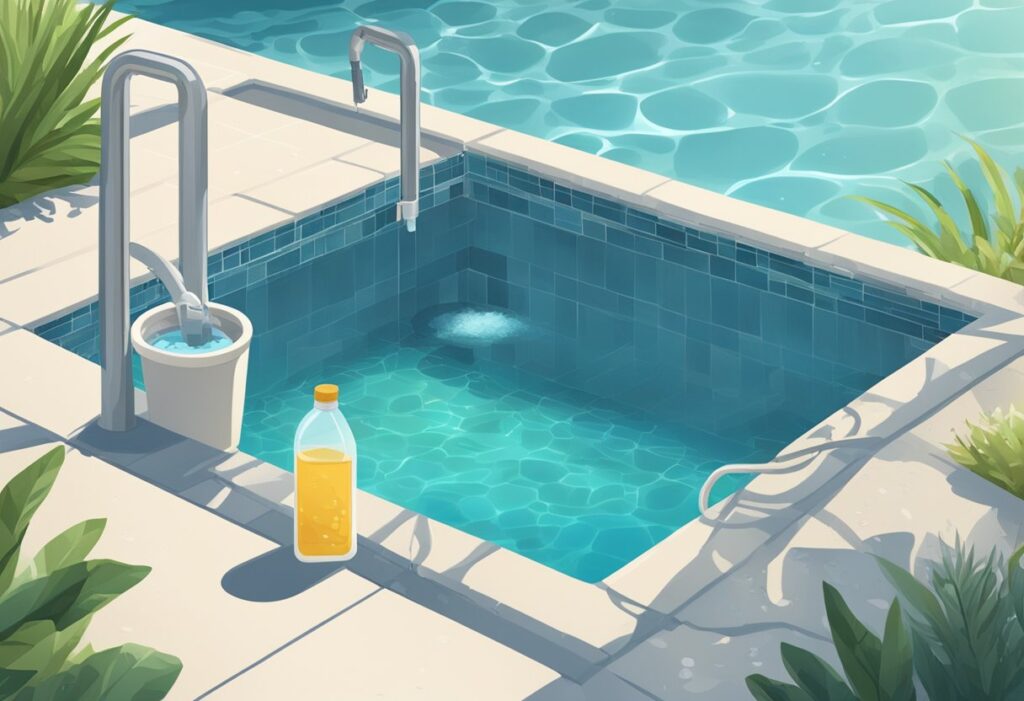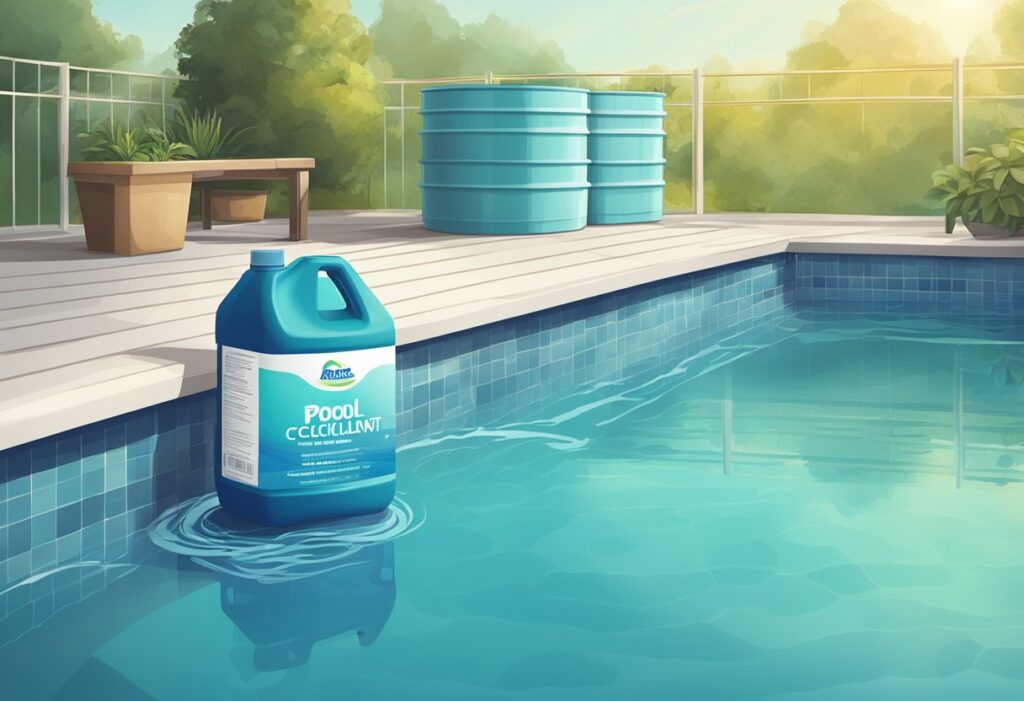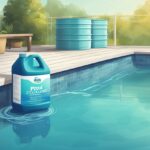When your pool water turns cloudy, it can be both unappealing and potentially unhygienic. Achieving clear water is a priority for any pool owner, and two popular solutions are pool flocculants and clarifiers. Pool flocculant is a chemical additive that gathers suspended particles in your pool water causing them to settle at the bottom. This process, known as flocculation, allows you to physically remove these particles by vacuuming them out of the pool. It’s a rapid solution typically used when water clarity has been compromised and common filtration methods are insufficient.

In contrast, a clarifier is a gentler option that also improves water clarity. It works by coagulating fine particles into larger formations that your pool’s filter system can then capture. While clarifiers are ideal for treating slightly cloudy water, they may take longer to achieve results compared to flocculants. The choice between using a flocculant or a clarifier often depends on the severity of the cloudiness and your maintenance preferences.
Flocculants are powerful agents in restoring water clarity, especially after incidents that severely disturb the pool’s balance. However, it’s important to note that after adding a flocculant, you should leave your pool undisturbed overnight, and you will need to bypass your filter system to avoid clogging since the process concentrates debris at the bottom of the pool for removal. Your pool water can be crystal clear within a day or two, but bear in mind this method requires a bit more manual labour.
Understanding Pool Flocculant
In your pursuit of crystal-clear pool water, understanding how pool flocculants work is essential. These chemicals act swiftly to coagulate fine particles, causing them to sink and facilitating easier removal.
Chemical Composition and Function
Flocculants: Your go-to chemicals for when the pool water becomes stubbornly cloudy. They’re specially formulated to bind together minute particles into larger ones that readily sink to the pool floor. This process, known as coagulation, is crucial because it turns the fine, often invisible particles into a mass heavy enough to be removed with ease.
- Chemical composition: Flocculants are typically composed of polymeric compounds that increase their efficacy in binding particles.
- Function: Upon adding the correct dosage to your pool, these chemicals disperse throughout the water, causing fine debris, algae, and other particulate matter to coalesce.
- Dosage and dosing: It’s vital to follow manufacturer guidelines for the appropriate amount. Dosage typically depends on your pool’s water volume and the severity of the cloudiness.
Comparing Pool Flocculant to Clarifier
While pool flocculant and clarifiers both aim to improve water clarity, their approaches and effectiveness differ.
Mechanism: Flocculant causes particles to form heavy clumps that sink, necessitating manual vacuuming. Clarifiers, in contrast, coagulate particles into smaller clumps that your pool’s filter can catch.
- Flocculants: Sink particles to the bottom.
- Clarifiers: Particles remain suspended, removed by filtration.
-
Effectiveness: Your choice between these two might depend on your needs. Flocculant acts fast and is more thorough, suitable for severe cloudiness where a filter alone can’t cope. Clarifiers, on the other hand, are less labor-intensive as they utilise your pool’s filter system over time.
-
Water Balance: It’s important to test and balance your pool water, ensuring pH, total alkalinity, and calcium hardness are within ideal ranges before adding either chemical. The effectiveness of the flocculant depends on these levels, as poor water balance can reduce the efficacy of coagulation.
In summary, the choice between a flocculant and a clarifier depends on your specific circumstances, how quickly you need results, and how much effort you’re willing to put into the cleanup process.
Application Process of Pool Flocculant
Proper application of pool flocculant involves a systematic approach to ensure that the suspended particles in your pool water are effectively clumped together and settled at the bottom, ready for removal. It’s a process that requires precision and a bit of manual work, but when executed correctly, can lead to dramatically clearer water.
Steps for Adding Flocculant to Your Pool
Before adding flocculant, ensure that your pool’s pH, total alkalinity, and calcium hardness are within the ideal ranges. Test the water and adjust these levels if necessary. Follow these steps to add flocculant into your pool:
- Turn off your pool’s filtration system to prevent the flocculant from being filtered out prematurely.
- If your pump has a multiport valve, set it to the “recirculate” position. This allows the water to move through the system without going through the filter media.
- Add the recommended amount of pool flocculant directly to the pool water, following the manufacturer’s instructions. Pool floc usually comes in liquid form, making it easy to distribute evenly.
- Turn on the pump for a couple of hours to help distribute the flocculant thoroughly.
Vacuuming After Flocculation
After allowing the flocculant to work—usually 8-24 hours—you’ll return to find that the particles have settled at the bottom of your pool. Now comes the slightly labour-intensive part: vacuuming.
- Set your multiport valve to the “waste” setting. This position bypasses the filter and sends the water directly out of the pool, preventing the trapped particles from clogging your filter system.
- Connect your manual pool vacuum to the pump and start vacuuming carefully. Your aim is to pick up the floc without disturbing it too much, thus keeping the water above mostly clear.
- Work slowly, vacuuming the debris that’s now clumped together and sunk to the bottom. Keep an eye on the water level, as you’ll be sending water to waste; you may need to add more water to your pool during this process.
- Continue until you’ve removed all debris. The process can be labour-intensive, as it requires patience and attention to ensure all waste is vacuumed up without dispersing the floc.
Remember, using a pool flocculant and vacuuming to waste is an effective means of clearing very cloudy water, but it demands your time and effort to achieve the best results.
Assessing the Efficacy and Alternatives
When selecting a method to improve water clarity in your swimming pool, it’s important to weigh the benefits of pool flocculant against its potential drawbacks, as well as to consider alternative solutions.
Advantages of Pool Flocculant Over Alternatives
Pool flocculant boasts several advantages for treating cloudy pool water. Unlike other methods, it gathers tiny particles—including contaminants and organic compounds—that contribute to water cloudiness and causes them to sink to the bottom of your swimming pool. This process, often described as floc and drop, is especially beneficial in scenarios where pool water is extensively clouded to the point where the bottom of the pool is not visible.
- Quick Action: Flocculant can rapidly clump together these fine particles, allowing them to settle down promptly, typically faster than using a pool clarifier.
- Water Clarity: When utilised correctly, flocculant significantly restores water clarity, which can be particularly noticeable in pools that have persistently struggled with cloudiness.
It is essential to get your pH level, alkalinity, and calcium hardness into the ideal ranges before application. Also, you need to set your filter to recirculate to prevent filter media clogging. Remember that, after application, you should turn off your pool pump to allow particles to settle.
Potential Drawbacks and Considerations
Despite its powerful clearing capability, using pool flocculant requires additional steps that could be considered drawbacks:
- Manual Removal Required: Once the particles are settled at the bottom, you must manually vacuum them out of the pool. An automatic or robotic cleaner won’t suffice, as it can redistribute the particles instead of removing them.
- Incompatibility With Some Filters: Not all filters, like cartridge filters, can handle the debris load that results from a flocculant treatment. Sand and DE (diatomaceous earth) filters are generally better suited to cope with the waste produced.
Filtration Concerns: Post-flocculant water still contains a high level of particulates until they fully settle down. Avoid backwashing or cleaning the filter media immediately after treatment to not unsettle the clumps.
While flocculant treatment is an effective method of pool maintenance for restoring water clarity in a cloudy pool, consider the requirements of pool vacuuming and the compatibility with your filtration system. Alternatives such as clarifiers, which work more slowly by clumping particles so they can be trapped in the skimmer or filter media, may be better suited for pools with certain types of filters, and for owners seeking less hands-on intervention.
Maintaining Pool Water Health

Ensuring your pool’s water is healthy involves regular cleaning to remove debris and balancing the water chemistry. These steps prevent the proliferation of bacteria and algae, contributing to a clean and clear swimming environment.
Regular Cleaning and Maintenance Procedures
Your pool requires consistent cleaning to prevent the accumulation of debris that can cloud the water and harbour bacteria. Skim the surface daily to remove leaves and other floating debris. Brush the walls and floor weekly to dislodge any clinging dirt or algaecide-resistant algae. Make sure to clean your filter cartridge as recommended by the manufacturer, as a clogged filter diminishes efficiency and can return dirty water to the pool. Regularly check and clean the strainer baskets in your skimmer and pump as well to maintain optimum water flow.
Balancing Water Chemistry for Optimal Results
Balancing your pool’s water chemistry is critical for healthy swimming conditions. Your pool’s pH levels should be maintained between 7.4 and 7.6 to ensure maximum efficacy of chlorine and to prevent irritation to swimmers’ skin and eyes. Regularly test your water and adjust with pH increasers or decreasers as necessary.
- Chlorine should be kept within the range of 1-3 ppm; it’s your primary defence against harmful microorganisms.
- Apply algaecide periodically to prevent the growth of living algae, which can cause cloudiness and health issues.
- Make sure the total alkalinity is between 80-120 ppm which helps stabilise the pH level.
- Calcium hardness should be in the range of 200-400 ppm to protect pool equipment from corrosion or scaling.
When you encounter cloudy pool water that cannot be cleared by these chemical adjustments or your usual sanitisation routines, a pool flocculant can be utilised. Flocculants act by coagulating fine particles into larger clumps, which then settle to the bottom and can be vacuumed out. This process is efficient but requires the pool to be out of use as the debris settles, followed by manual removal of the coagulated debris.











